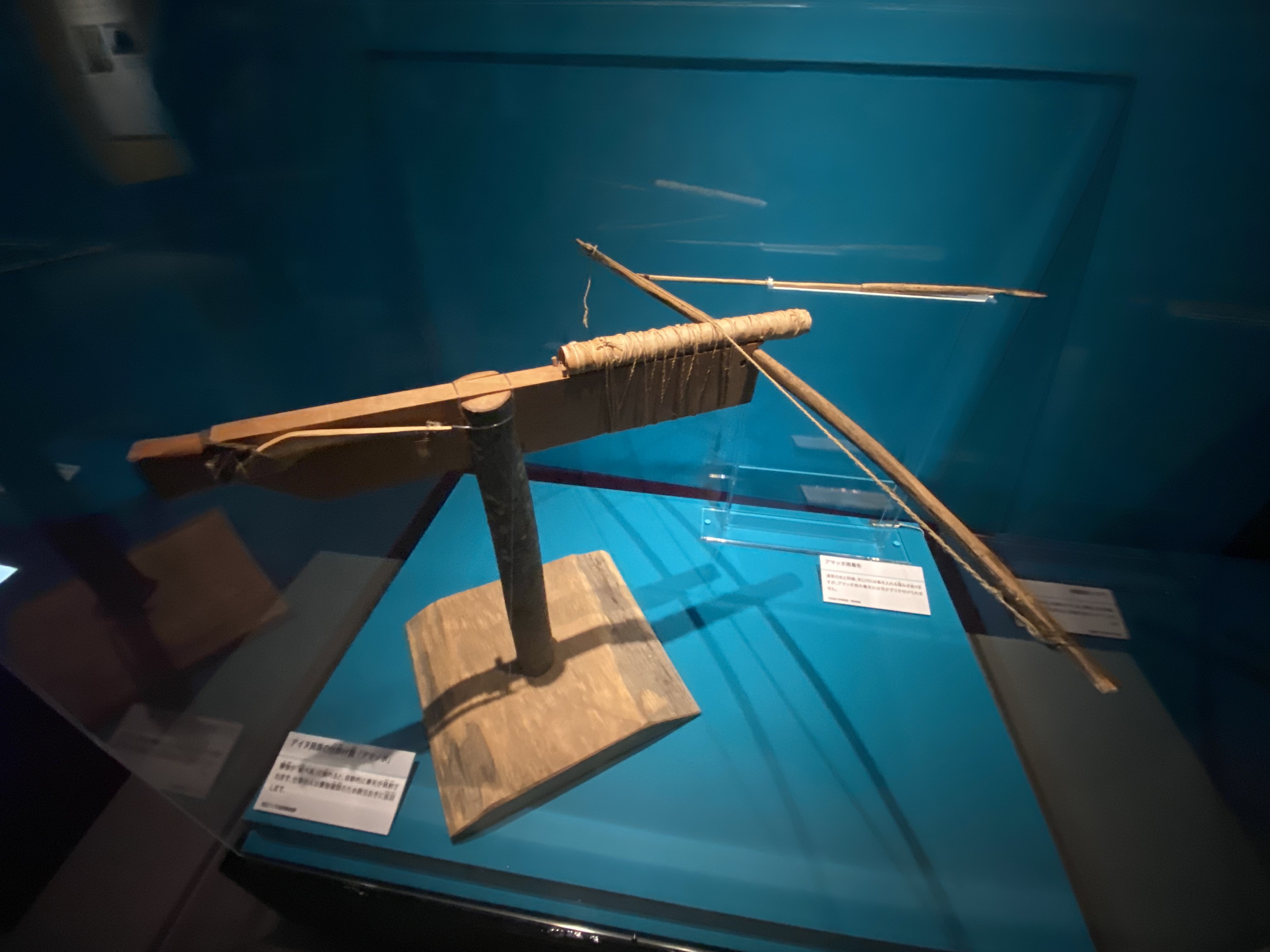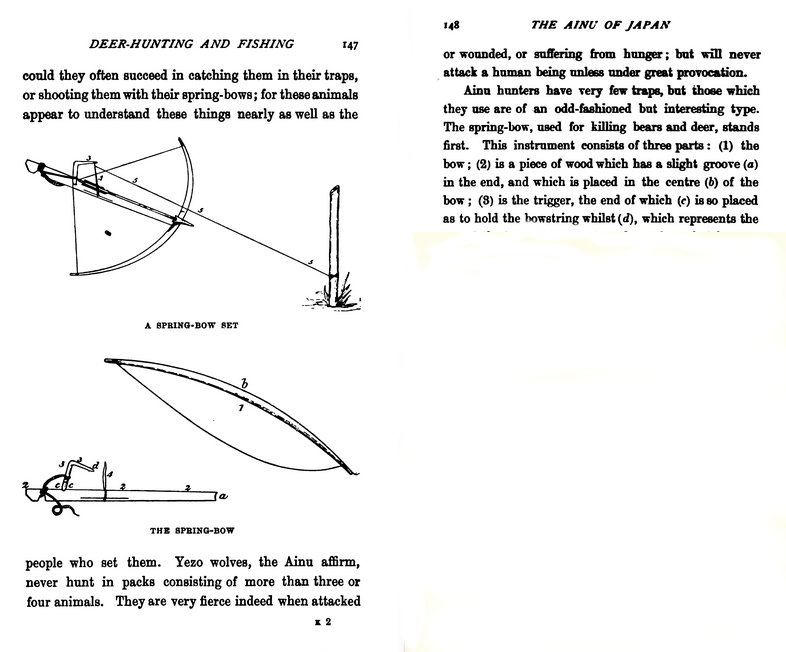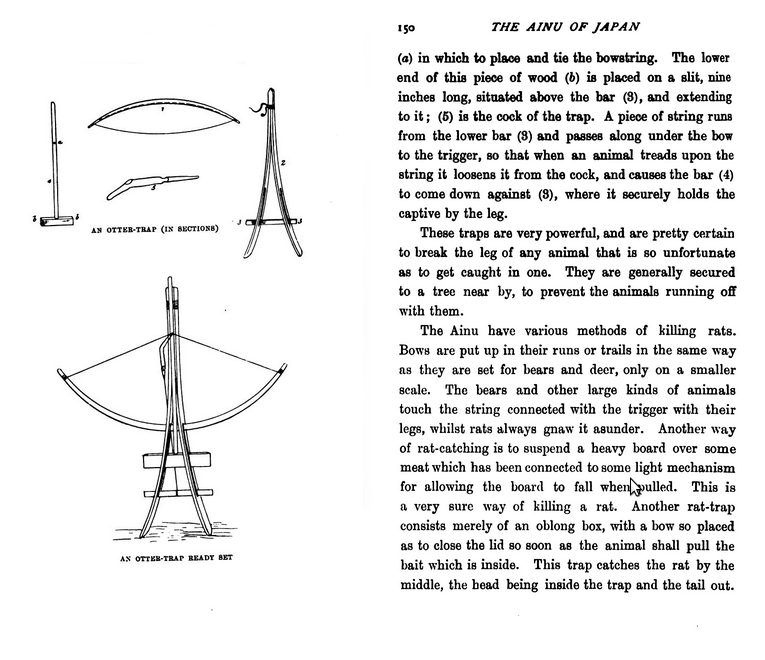Amappo on:
[Wikipedia]
[Google]
[Amazon]



 An was a traditional
An was a traditional



 An was a traditional
An was a traditional bear
Bears are carnivoran mammals of the family (biology), family Ursidae (). They are classified as caniforms, or doglike carnivorans. Although only eight species of bears are extant, they are widespread, appearing in a wide variety of habitats ...
and deer
A deer (: deer) or true deer is a hoofed ruminant ungulate of the family Cervidae (informally the deer family). Cervidae is divided into subfamilies Cervinae (which includes, among others, muntjac, elk (wapiti), red deer, and fallow deer) ...
hunters' trap of the Ainu people
The Ainu are an Indigenous peoples, indigenous ethnic group who reside in northern Japan and southeastern Russia, including Hokkaido and the Tōhoku region of Honshu, as well as the land surrounding the Sea of Okhotsk, such as Sakhalin, the Ku ...
of the northern Japanese archipelago
The is an archipelago of list of islands of Japan, 14,125 islands that form the country of Japan. It extends over from the Sea of Okhotsk in the northeast to the East China Sea, East China and Philippine Sea, Philippine seas in the southwest al ...
and Sakhalin
Sakhalin ( rus, Сахали́н, p=səxɐˈlʲin) is an island in Northeast Asia. Its north coast lies off the southeastern coast of Khabarovsk Krai in Russia, while its southern tip lies north of the Japanese island of Hokkaido. An islan ...
. ''Amappo''-based traps were also used by ethnic Japanese matagi
The are traditional winter hunters of the Tōhoku region of northern Japan, most famously today in the Ani area in Akita Prefecture, which is known for the Akita dogs. Afterwards, they spread to the Shirakami-Sanchi forest between Akita and ...
hunters.
Summary
Mechanically, the ''amappo'' was a simplecrossbow
A crossbow is a ranged weapon using an Elasticity (physics), elastic launching device consisting of a Bow and arrow, bow-like assembly called a ''prod'', mounted horizontally on a main frame called a ''tiller'', which is hand-held in a similar f ...
of elastic yew
Yew is a common name given to various species of trees.
It is most prominently given to any of various coniferous trees and shrubs in the genus '' Taxus'':
* European yew or common yew (''Taxus baccata'')
* Pacific yew or western yew ('' Taxus ...
wood set in a notch at the top of a short post or tree stump
After a tree has been cut and has fallen, the stump or tree stump is usually a small remaining portion of the trunk with the roots still in the ground. Stumps may show the age-defining rings of a tree. The study of these rings is known as dendr ...
. A stump prepared for this purpose was called a . A release mechanism actuated by a tripwire
A tripwire is a passive triggering mechanism. Typically, a wire or cord is attached to a device for detecting or reacting to physical movement.
Military applications
Such tripwires may be attached to one or more minesespecially fragme ...
was strung across a game trail
A desire path, also known as desire line in transportation planning and many other names, is an unplanned small trail formed by erosion caused by human or animal traffic. The path usually represents the shortest or the most easily navigated rout ...
. When an animal traversing the path disturbed the tripwire, a loaded arrow was released. These arrows were wrapped in birchbark
Birch bark or birchbark is the bark of several Eurasian and North American birch trees of the genus ''Betula''.
For all practical purposes, birch bark's main layers are the outer dense layer, white on the outside, and the inner porous layer ( ...
to protect them from rain, marked with an , or family symbol, to indicate ownership of the kill, and coated with a paste of , a lethal poison derived from aconitum
''Aconitum'' (), also known as aconite, monkshood, wolfsbane, leopard's bane, devil's helmet, or blue rocket, is a genus of over 250 species of flowering plants belonging to the family (biology), family Ranunculaceae. These herbaceous perennial ...
ground in a mortar and pestle
A mortar and pestle is a set of two simple tools used to prepare ingredients or substances by compression (physics), crushing and shear force, grinding them into a fine Paste (rheology), paste or powder in the kitchen, laboratory, and pharmacy. ...
specially set aside for the purpose. This style of trap originated in eastern Siberia
Siberia ( ; , ) is an extensive geographical region comprising all of North Asia, from the Ural Mountains in the west to the Pacific Ocean in the east. It has formed a part of the sovereign territory of Russia and its predecessor states ...
. On the Japanese archipelago, ''amappo'' are believed to have been in use since at least the Neolithic
The Neolithic or New Stone Age (from Ancient Greek, Greek 'new' and 'stone') is an archaeological period, the final division of the Stone Age in Mesopotamia, Asia, Europe and Africa (c. 10,000 BCE to c. 2,000 BCE). It saw the Neolithic Revo ...
period.
In the early Meiji era
The was an Japanese era name, era of History of Japan, Japanese history that extended from October 23, 1868, to July 30, 1912. The Meiji era was the first half of the Empire of Japan, when the Japanese people moved from being an isolated feu ...
, the setting of ''amappo'' was banned by the Kaitakushi in favor of hunting by firearm
A firearm is any type of gun that uses an explosive charge and is designed to be readily carried and operated by an individual. The term is legally defined further in different countries (see legal definitions).
The first firearms originate ...
.
Use
Hunting by ''amappo'' was usually carried out inspring
Spring(s) may refer to:
Common uses
* Spring (season), a season of the year
* Spring (device), a mechanical device that stores energy
* Spring (hydrology), a natural source of water
* Spring (mathematics), a geometric surface in the shape of a he ...
and autumn
Autumn, also known as fall (especially in US & Canada), is one of the four temperate seasons on Earth. Outside the tropics, autumn marks the transition from summer to winter, in September (Northern Hemisphere) or March ( Southern Hemisphe ...
, when dense foliage made sighting prey more difficult and cold weather slowed the decomposition
Decomposition is the process by which dead organic substances are broken down into simpler organic or inorganic matter such as carbon dioxide, water, simple sugars and mineral salts. The process is a part of the nutrient cycle and is ess ...
of carcasses.
The elevation of the tripwire was adjusted depending on the animal being targeted in order to improve the chance of the arrow striking the heart
The heart is a muscular Organ (biology), organ found in humans and other animals. This organ pumps blood through the blood vessels. The heart and blood vessels together make the circulatory system. The pumped blood carries oxygen and nutrie ...
. For example, a tripwire for deer would be strung roughly 10 centimeters higher than that for a bear.
A number of methods were developed to prevent passersby from inadvertently tripping an ''amappo''. For one, the tripwire was typically allowed a degree of slack so that the trajectory of a released arrow would pass behind the thigh of a standing person. Another technique was to carve images of bows and arrows into nearby tree trunks to warn about the presence of an ''amappo''.
Preparation, efficacy, and handling of ''surku''
Although many recipes for ''surku'' were handed down by different Ainu villages, aconitum was always the base. Aconitum roots and stalks gathered in the mountains were allowed to dry for at least one month before being ground and mixed with water, whereupon the strength of the poison would be tested. If the level of toxicity was too low, even if the arrow hit the target, the prey would escape. Conversely, if the toxicity was too strong, the poison would spread throughout the prey's body, rendering its meat inedible. Furthermore, in cases of excessive toxicity, the animal'sfur
A fur is a soft, thick growth of hair that covers the skin of almost all mammals. It consists of a combination of oily guard hair on top and thick underfur beneath. The guard hair keeps moisture from reaching the skin; the underfur acts as an ...
would soon fall out, ruining even the pelt. However, when hunters faced a , the greatest possible level of toxicity was used as the meat and pelts of such animals were taboo
A taboo is a social group's ban, prohibition or avoidance of something (usually an utterance or behavior) based on the group's sense that it is excessively repulsive, offensive, sacred or allowed only for certain people.''Encyclopædia Britannica ...
.
According to information obtained by the surgeon
In medicine, a surgeon is a medical doctor who performs surgery. Even though there are different traditions in different times and places, a modern surgeon is a licensed physician and received the same medical training as physicians before spec ...
from the Ainu of the Saru River
is a river in Hokkaido, Japan.
The Saru River rises in the Hidaka Mountains and empties into the Pacific. It is considered sacred in traditional Ainu beliefs.
The Nibutani Dam is situated on the Saru River, at Nibutani village. The construct ...
and Hidaka Mountains
The are a mountain range in southeastern Hokkaido, Japan. It runs from Mount Sahoro or Karikachi Pass in central Hokkaidō south, running into the sea at Cape Erimo. It consists of folded mountains that range from in height. Mount Poroshiri ...
, brown bear
The brown bear (''Ursus arctos'') is a large bear native to Eurasia and North America. Of the land carnivorans, it is rivaled in size only by its closest relative, the polar bear, which is much less variable in size and slightly bigger on av ...
s poisoned with ''surku'' initially react violently but gradually become quiet, stiffening their limbs and foaming at the mouth before dying after about two hours. If the ''surku'' was formulated to have stronger toxicity, it will kill within one hour.
The meat of animals killed by ''surku'' could be eaten as long as "a fistful" of tissue was gouged out from around the site of the arrow impact and discarded. However, even the remaining meat could never be eaten raw, and needed to be cooked.
See also
*Spring-gun
A spring-gun, also known as a booby trap gun, is a gun, often a shotgun, rigged to fire when a string or other triggering device is tripped by contact of sufficient force to "spring" the trigger (firearms), trigger so that anyone stumbling over o ...
References
{{Authority control Ainu culture Ancient weapons Japanese inventions Hunting equipment Hunting in Japan Tripwire weapons Crossbows